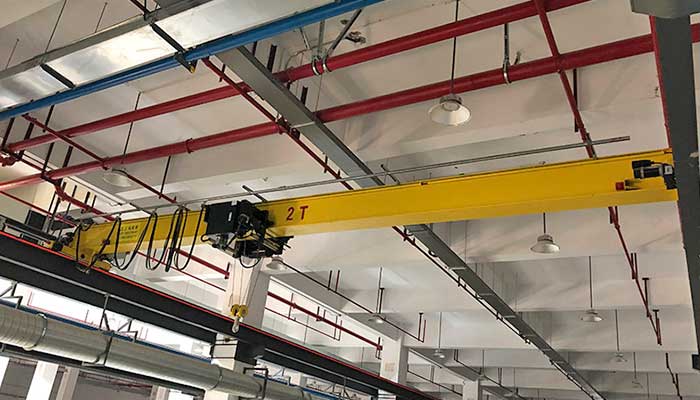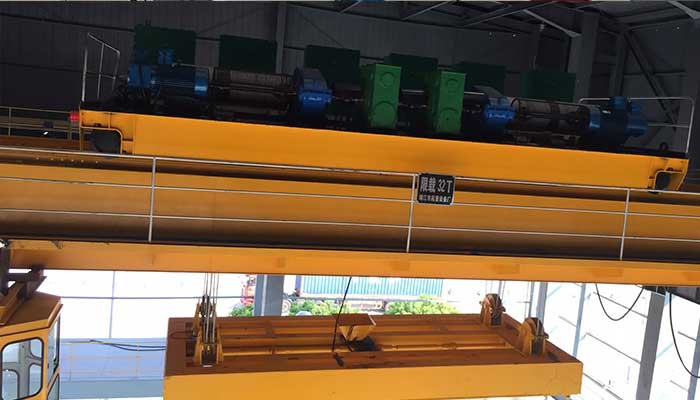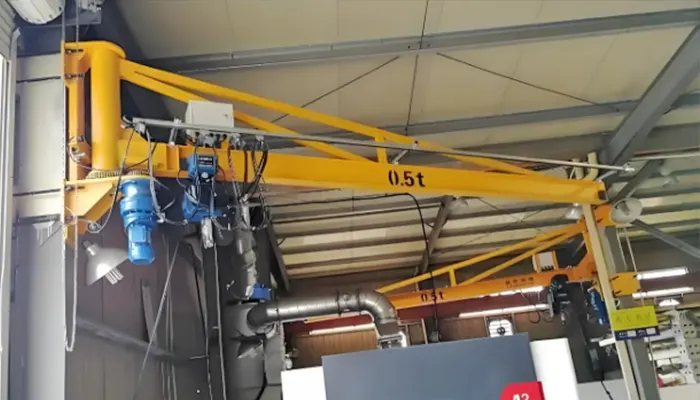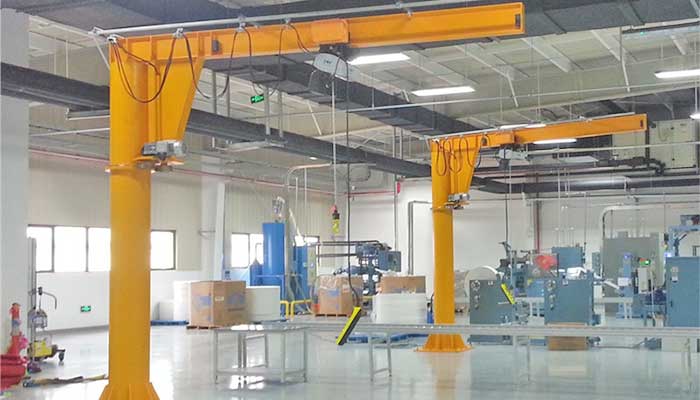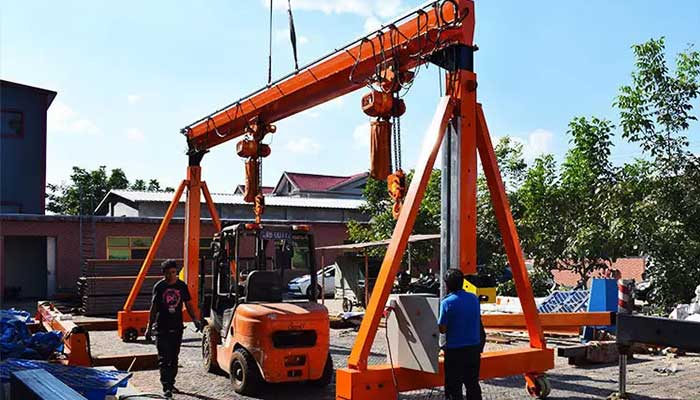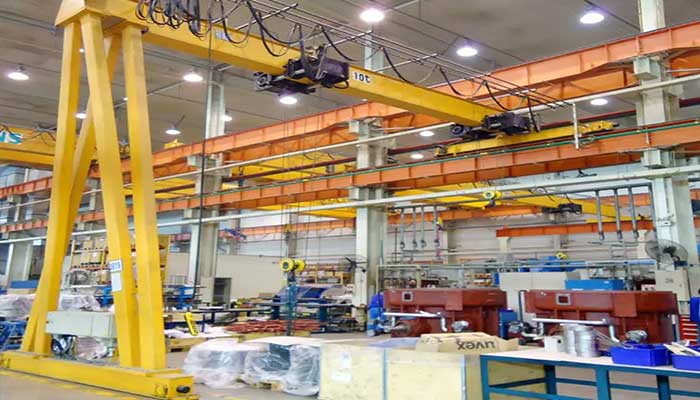Maintenance Cranes for Sale – Reduce Your Downtime
Maintenance cranes for sale, types of maintenance cranes for your selection, to minimize downtime and boost efficiency in your industrial operations.
Category: Maintenance Crane
Your Trusted Overhead Maintenance Crane Manufacturer & Supplier
Maintenance Cranes for Sale – Reduce Your Downtime
Maintenance cranes for sale, types of maintenance cranes for your selection, to minimize downtime and boost efficiency in your industrial operations.
Maintenance cranes are specialized lifting devices designed to assist in the upkeep and repair of equipment and machinery across various industries. Unlike standard cranes used for construction or heavy lifting, maintenance cranes are tailored for tasks that involve frequent adjustments, repairs, and servicing of equipment. They are typically used in settings such as factories, workshops, power plants, and warehouses where efficient and safe handling of components is crucial.
Importance of Maintenance Cranes in Reducing Downtime
The primary role of maintenance cranes is to minimize operational downtime by facilitating quick and efficient maintenance tasks. By providing a reliable means to lift, move, and position heavy or awkward equipment, these cranes help prevent delays caused by equipment failure or maintenance issues. This efficiency not only accelerates repair processes but also ensures that machinery remains in good working condition, thereby extending its lifespan and reducing the frequency of unexpected breakdowns.
Selecting the right maintenance crane is crucial for optimizing maintenance processes and minimizing downtime. This guide will assist readers in making informed purchasing decisions by detailing the various crane options available, their applications, and their suitability for different industrial settings. By providing insights into how to evaluate and compare cranes based on specific requirements, the guide aims to help buyers choose equipment that best fits their operational needs and budget, ultimately enhancing their overall efficiency and productivity.
Maintenance Crane
Maintenance cranes are specialized lifting devices designed to handle, move, and position equipment and components during maintenance and repair activities in various industrial settings. These cranes are essential for performing tasks that involve heavy, bulky, or awkwardly shaped items that need to be lifted safely and efficiently.
Importance of Maintenance Cranes in Industrial Settings
Maintenance cranes are crucial in industrial environments for several reasons:
- Safety: They ensure that heavy or cumbersome equipment can be lifted and moved safely, reducing the risk of injury to personnel.
- Efficiency: By automating the lifting and positioning of large or heavy components, maintenance cranes speed up maintenance and repair tasks, minimizing downtime and improving overall productivity.
- Precision: These cranes provide the accuracy needed to handle delicate or critical parts without causing damage, ensuring that equipment is maintained to high standards.
- Versatility: Maintenance cranes are adaptable to various tasks and environments, making them valuable across different industries for handling a wide range of equipment and materials.
Overview of Different Types of Cranes Used for Maintenance Tasks
Several types of cranes are commonly used in maintenance tasks, each offering specific advantages based on the type of work and the nature of the loads being handled:
- Overhead Cranes: These cranes are mounted on rails that run along the top of a building or workshop, allowing them to cover a large area. They are ideal for lifting and moving heavy equipment like reactors, vessels, and machinery components.
- Gantry Cranes: Positioned on legs that move along tracks, gantry cranes are used for tasks that require lifting heavy loads and moving them over significant distances. They are versatile and can be used indoors or outdoors for maintenance tasks involving large equipment.
- Jib Cranes: These cranes have a horizontal arm (jib) that extends from a vertical column. They are well-suited for tasks that require precision and flexibility, such as handling smaller components, machinery parts, and equipment in confined spaces.
- KBK Cranes: Known for their modular design and ease of installation, KBK crane systems are ideal for handling lighter loads in smaller workshops or assembly lines. They are highly flexible and can be adapted to various configurations to fit different maintenance needs.
- Monorail Systems: These cranes operate on a single rail and are used for moving loads along a fixed path. They are particularly useful in environments where space is limited and there is a need for straightforward, repetitive movement of materials or components.
- Underhung Cranes: Similar to overhead cranes but mounted below the main support structure, underhung cranes are used when overhead space is limited. They offer flexibility in smaller areas and are effective for maintenance tasks in compact environments.
Each type of maintenance crane has unique features and benefits, making them suitable for specific tasks and environments in industrial settings. Their proper use ensures that maintenance operations are carried out efficiently, safely, and effectively.
Capacity of Mainteance Cranes
Overhead Cranes
- Single Girder Overhead Cranes Typical Capacities: 1 ton to 10 tons. Popular Capacities: 2 tons, 5 tons, 10 tons
- Double Girder Overhead Cranes Typical Capacities: 10 tons to 100 tons. Popular Capacities: 15 tons, 20 tons, 30 tons, 50 tons, 75 tons
Gantry Cranes
- Single Girder Gantry Cranes Typical Capacities: 1 ton to 15 tons. Popular Capacities: 2 tons, 5 tons, 10 tons, 15 tons
- Double Girder Gantry Cranes Typical Capacities: 10 tons to 100 tons. Popular Capacities: 20 tons, 30 tons, 40 tons, 50 tons, 100 tons
Semi-Gantry Cranes
- Indoor Semi-Gantry Cranes Typical Capacities: 1 ton to 20 tons. Popular Capacities: 2 tons, 5 tons, 10 tons, 20 tons
- Outdoor Semi-Gantry Cranes Typical Capacities: 10 tons to 50 tons. Popular Capacities: 20 tons, 30 tons, 40 tons, 50 tons
Jib Cranes
- Wall-Mounted Jib Cranes Typical Capacities: 0.5 ton to 5 tons. Popular Capacities: 1 ton, 2 tons, 3 tons, 5 tons
- Floor-Mounted Jib Cranes Typical Capacities: 1 ton to 10 tons. Popular Capacities: 2 tons, 5 tons, 7.5 tons, 10 tons
- Articulating Jib Cranes Typical Capacities: 0.5 ton to 3 tons. Popular Capacities: 1 ton, 2 tons, 3 tons
Portable Gantry Cranes
- Manual Portable Gantry Cranes Typical Capacities: 0.5 ton to 3 tons. Popular Capacities: 1 ton, 2 tons, 3 tons
- Motorized Portable Gantry Cranes Typical Capacities: 1 ton to 5 tons. Popular Capacities: 2 tons, 3 tons, 5 tons
Importance of Selecting the Right Type Based on Specific Maintenance Needs
Choosing the appropriate crane type for maintenance tasks is crucial for several reasons:
- Load Capacity: Each crane type has a specific weight limit it can handle. Selecting a crane with adequate capacity ensures safe and efficient lifting of heavy equipment or components.
- Space Constraints: The physical layout and available space in a facility influence crane selection. For example, jib cranes and underhung cranes are ideal for confined areas, while gantry cranes are suitable for open spaces.
- Flexibility and Precision: Different cranes offer varying degrees of flexibility and precision. Jib cranes and KBK cranes, for instance, are better for tasks requiring precise movements and adjustments.
- Working Environment: The environment where the crane will be used—whether indoors, outdoors, or in hazardous conditions—affects crane choice. Gantry cranes and overhead cranes are often used in larger, open environments, while KBK cranes and monorails are suited for smaller, more controlled spaces.
- Safety: The right crane ensures that maintenance tasks are performed safely, minimizing risks associated with lifting and moving heavy or delicate loads.
Selecting the appropriate maintenance crane based on these factors enhances operational efficiency, safety, and overall productivity in industrial settings.
Main Types of Maintenance Cranes for Sale
Maintenance cranes come in various types, each suited to specific applications and requirements. Here's a detailed look at the main types of maintenance cranes available for sale, categorized by their design, functionality, and typical applications:
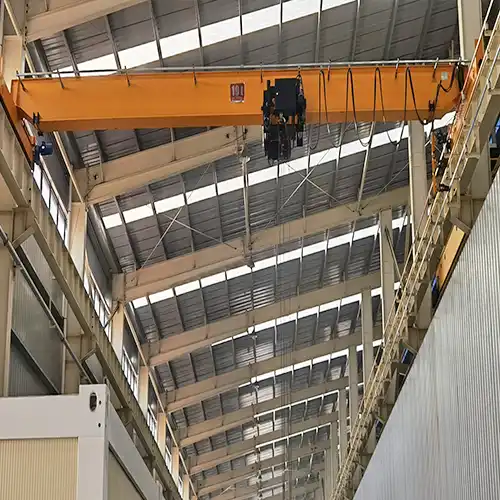
Description and Key Features: Overhead cranes, also known as bridge cranes, are mounted on rails fixed to the ceiling or upper structures of a facility. They consist of a hoist, trolley, and bridge, allowing movement both horizontally and vertically.
Applications and Typical Load Capacities:
- Applications: Ideal for large-scale maintenance tasks, such as lifting and moving heavy equipment across extensive areas. Commonly used in manufacturing plants, warehouses, and workshops.
- Load Capacities: Generally range from 1 ton to over 100 tons, depending on the size and requirements.
Benefits for Reducing Downtime: Overhead cranes enhance operational efficiency by covering large areas and handling substantial loads, minimizing downtime during maintenance and repair tasks.
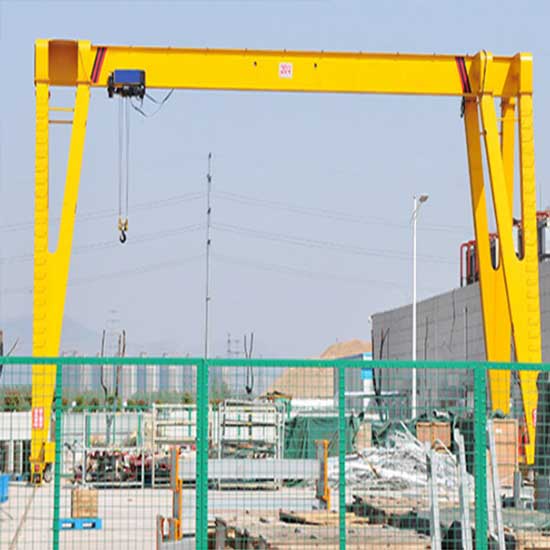
Description and Key Features: Gantry cranes are supported by legs that move on tracks, either on the ground or elevated rails. They can be configured with single or double girders to meet varying load requirements.
Applications and Typical Load Capacities:
- Applications: Suitable for both indoor and outdoor environments, such as shipyards, construction sites, and large warehouses. Ideal for heavy-duty maintenance and large-scale repairs.
- Load Capacities: Range from tons to over 100 tons, depending on the configuration and application.
Benefits for Reducing Downtime: Gantry cranes offer versatility and customization, allowing for efficient handling of oversized and heavy components, reducing maintenance time and improving overall productivity.
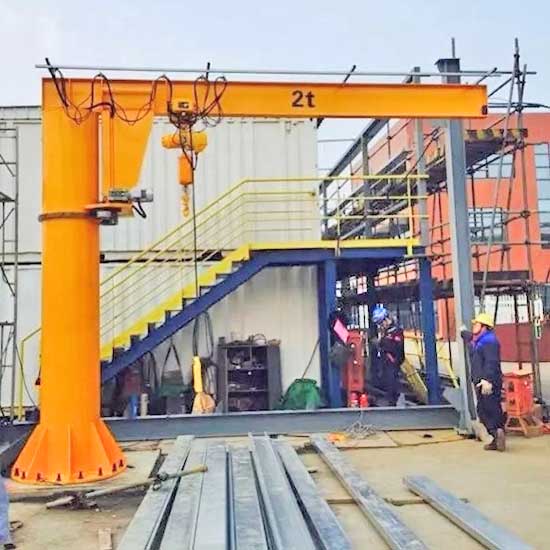
Description and Key Features: Jib cranes feature a horizontal arm (jib) that extends from a vertical support column. The arm rotates around the column to lift and move loads within a specific radius.
Applications and Typical Load Capacities:
- Applications: Ideal for tasks requiring precision and flexibility, such as lifting smaller components in confined spaces. Commonly used in automotive repair shops, assembly lines, and maintenance bays.
- Load Capacities: Typically range from 1 ton to 10 tons.
Benefits for Reducing Downtime: Jib cranes provide excellent maneuverability and precision, allowing for efficient handling of smaller components and minimizing downtime in areas with limited space.
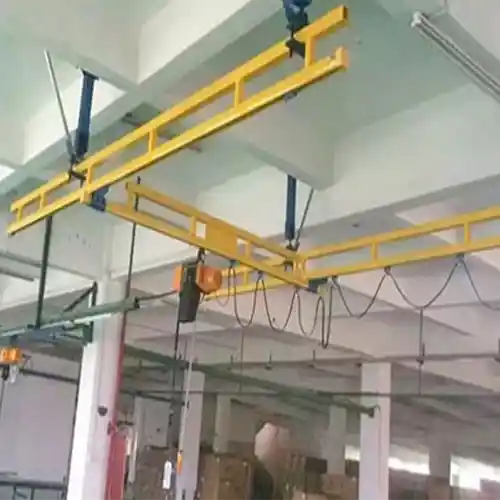
Description and Key Features: KBK cranes are modular systems with rail-mounted trolleys and hoists. They offer high flexibility and can be easily reconfigured or extended based on operational needs.
Applications and Typical Load Capacities:
- Applications: Ideal for lighter loads and applications requiring frequent reconfiguration, such as small workshops and assembly areas.
- Load Capacities: Typically range from 1 ton to tons.
Benefits for Reducing Downtime: The modular nature of KBK cranes allows for quick adjustments and reconfigurations, enhancing flexibility and reducing downtime during maintenance tasks.
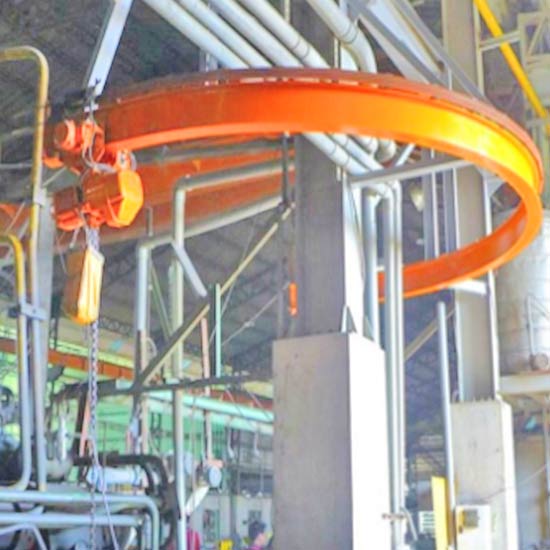
Description and Key Features: Monorail systems consist of a single rail along which a trolley moves. This design is suited for linear movement of loads within a facility.
Applications and Typical Load Capacities:
- Applications: Used in environments with limited space where loads need to be moved in a straight line, such as production lines and small workshops.
- Load Capacities: Typically range from 1 ton to tons.
Benefits for Reducing Downtime: Monorail systems provide efficient and precise movement along a fixed path, reducing the time required for material handling and improving overall operational efficiency.
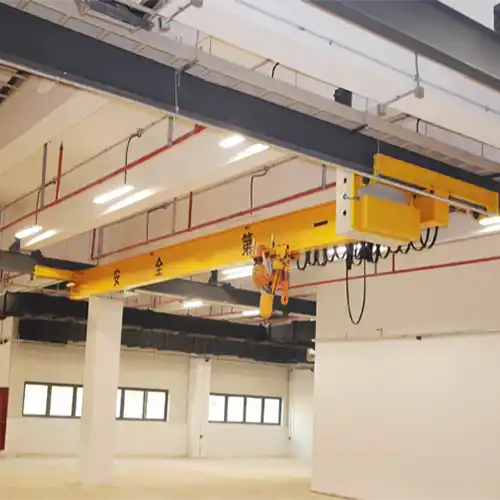
Description and Key Features: Underhung cranes are mounted below the main structural supports, such as beams or rafters. They operate within the existing overhead structure of a facility.
Applications and Typical Load Capacities:
- Applications: Suitable for facilities with limited overhead space where traditional overhead cranes cannot be used, such as smaller industrial settings and warehouses.
- Load Capacities: Typically range from 1 ton to 10 tons.
Benefits for Reducing Downtime: Underhung cranes maximize floor space and operate effectively in constrained environments, reducing downtime by efficiently handling loads in facilities with limited overhead clearance.
These various types of maintenance cranes offer distinct advantages based on their design and functionality, ensuring that businesses can choose the right crane to meet their specific operational needs and reduce downtime effectively.
Key Features to Consider
Load Capacity
Importance of Matching Crane Capacity to Maintenance Tasks
Selecting the right crane capacity is crucial for effective maintenance operations. The crane's load capacity must align with the weight and size of the equipment or components being handled. Using a crane with insufficient capacity can lead to safety hazards, equipment damage, or inefficient performance, while an oversized crane might result in unnecessary costs and space usage.
Examples of Typical Capacities for Different Industries
- Automotive Industry: Cranes typically handle loads from tons to 10 tons, suitable for lifting engines, transmissions, and heavy car parts.
- Aerospace Industry: High-capacity cranes ranging from 20 tons to 0 tons are used for managing large components like aircraft engines and fuselage sections.
- Oil and Gas Industry: Heavy-duty cranes with capacities from 10 tons to over 100 tons are needed for handling valves, pumps, and drilling equipment.
Mobility and Flexibility
Benefits of Mobile and Adjustable Cranes
Mobile and adjustable cranes offer significant advantages in maintenance settings. Their flexibility allows them to navigate around obstacles and reach various points within a facility. This adaptability is especially beneficial in environments where equipment and maintenance tasks are constantly changing or require relocation of the crane.
Examples of Cranes with High Mobility and Flexibility
- Gantry Cranes: Often equipped with adjustable heights and spans, making them suitable for both fixed and moving tasks.
- KBK Cranes: Modular design allows for easy reconfiguration and adjustment according to different maintenance needs.
- Jib Cranes: Their ability to rotate and extend the arm provides flexibility in accessing various points within confined spaces.
Precision and Control
Importance of Precise Load Handling
Precise load handling is essential for tasks that require accuracy and care, such as working with delicate components or performing intricate maintenance tasks. Cranes with high precision ensure that loads are lifted, moved, and placed with minimal deviation, reducing the risk of damage and improving overall efficiency.
Types of Cranes Offering High Precision for Delicate Tasks
- Jib Cranes: Known for their precise control in small, confined areas, ideal for handling smaller, sensitive components.
- Monorail Systems: Provide linear and accurate movement along a fixed path, suitable for repetitive and precise operations.
- Overhead Cranes: Advanced models equipped with precision controls for handling heavy yet delicate equipment with accuracy.
Ease of Installation and Use
Quick Setup and User-Friendly Operation
Cranes designed for easy installation and operation are vital for minimizing downtime and ensuring efficient maintenance processes. Features that facilitate quick setup and intuitive use help reduce training time and operational disruptions, allowing maintenance tasks to be performed with minimal delay.
Examples of Cranes Designed for Easy Installation and Operation
- KBK Cranes: Modular systems that are straightforward to install and adjust, allowing for rapid reconfiguration as needed.
- Jib Cranes: Simple installation process and ease of operation make them ideal for facilities with varying maintenance needs.
- Underhung Cranes: Designed to integrate with existing structural supports, minimizing installation complexity and ensuring efficient operation in constrained spaces.
Benefits of Reducing Downtime with the Right Crane
Increased Efficiency
How the Right Crane Improves Maintenance Speed and Effectiveness
Choosing the appropriate crane for maintenance tasks directly impacts operational efficiency. The right crane enables faster and more effective handling of equipment, which streamlines maintenance processes and minimizes delays. For instance, cranes with high load capacities and precision controls can perform complex tasks more quickly and accurately, leading to quicker repairs and less time spent on each maintenance activity. Additionally, mobile and adjustable cranes enhance workflow by allowing for easier access and maneuverability in various parts of a facility, further accelerating maintenance operations.
Enhanced Safety
Safety Benefits of Using Appropriate Cranes
Utilizing the right crane for maintenance tasks significantly enhances workplace safety. Cranes that are well-suited to their specific tasks and load capacities reduce the risk of accidents and injuries. For example, cranes with appropriate load limits ensure that heavy equipment is handled safely, preventing overloading and potential crane failure. Cranes with precise control mechanisms and stability features also minimize the risk of accidental drops or shifts, protecting both personnel and equipment. Proper crane usage and maintenance ensure that safety protocols are followed, reducing the likelihood of hazardous situations and improving overall workplace safety.
Cost Savings
Reduction in Maintenance Costs and Operational Downtime
Investing in the right crane can lead to substantial cost savings. Efficient cranes reduce the time needed for maintenance tasks, which translates to lower labor costs and decreased operational downtime. Additionally, cranes that are well-matched to their tasks are less likely to cause equipment damage or require frequent repairs, further reducing maintenance expenses. By minimizing downtime and ensuring that equipment operates smoothly, companies can avoid costly production interruptions and maximize their operational efficiency.
Improved Equipment Longevity
How Proper Crane Use Extends the Life of Machinery and Equipment
Using the right crane for maintenance tasks not only improves operational efficiency but also extends the lifespan of machinery and equipment. Proper handling with suitable cranes ensures that equipment is not subjected to undue stress or damage during maintenance activities. Cranes designed for specific loads and tasks prevent the overloading of equipment and reduce the risk of wear and tear. By maintaining equipment correctly and avoiding unnecessary strain, companies can prolong the service life of their machinery, leading to fewer replacements and repairs over time. This proactive approach to equipment maintenance contributes to overall cost savings and operational reliability.
Hot Sale Overhead Cranes for Various Maintenance Works
Maintenance cranes are designed to meet the specific requirements of different industrial environments and tasks. Here's a breakdown of the main types of cranes used in maintenance operations:
Overhead Cranes
Overhead cranes are mounted on rails installed along the ceiling or upper structure of a facility. They include a hoist, trolley, and bridge that can move horizontally and vertically. Best suited for large-scale operations requiring the movement of heavy and bulky items across a wide area. They are commonly found in manufacturing plants, warehouses, and workshops.
Advantages:
- Wide Coverage: Able to cover a large working area.
- Heavy Load Capacity: Capable of handling very heavy loads.
- Versatility: Suitable for various maintenance tasks involving large equipment.
Overhead cranes are vital for handling heavy loads and moving large equipment in various maintenance settings. They come in different configurations, each designed to meet specific needs based on load capacity, workspace, and application requirements. Here are some popular types of overhead cranes for maintenance works:
Single Girder Overhead Cranes
These cranes feature a single beam (girder) mounted on end trucks, with the hoist and trolley running along the girder. They are ideal for light to medium-duty applications.Single girder overhead cranes are widely used in various industrial applications due to their cost-effectiveness and versatility. These cranes typically offer load capacities ranging from 1 ton to 10 tons. The most popular capacities in this category include 2 tons, 5 tons, and 10 tons, making them suitable for light to medium-duty tasks.
- Key Features:
- Compact Design: Efficient for smaller spaces with limited headroom.
- Cost-Effective: Typically more affordable compared to double girder cranes.
- Simple Operation: Easy to maintain and operate with straightforward controls.
Double Girder Overhead Cranes
Double girder cranes have two parallel beams supporting the hoist and trolley system, providing greater strength and stability for handling heavier loads. For heavier lifting requirements, double girder overhead cranes are the preferred choice. These cranes handle capacities ranging from 10 tons to 100 tons, with popular capacities including 15 tons, 20 tons, 30 tons, 50 tons, and 75 tons. Their robust design supports higher loads and is ideal for heavy-duty industrial operations.
- Key Features:
- High Load Capacity: Capable of lifting heavier loads, ranging from 10 tons to over 100 tons.
- Enhanced Stability: Offers increased rigidity and stability, making it suitable for demanding applications.
- Versatile: Can be equipped with various hoists and lifting mechanisms for different needs.
Typical Applications
Overhead cranes are used in numerous maintenance tasks across various industries:
- Automotive Assembly Lines: Lifting and moving engines, transmissions, and other heavy components during assembly, repair, or reconfiguration of production lines.
- Aerospace Maintenance: Handling and positioning aircraft parts, engines, and equipment for maintenance, repair, and overhauls.
- Large Manufacturing Plants: Moving and maintaining large machinery, equipment, and materials in facilities that require extensive coverage and heavy load handling.
- Light to Medium Loads: Single girder overhead cranes typically handle loads from 5 tons to 20 tons, making them suitable for lighter maintenance tasks.
- Heavy Loads: Double girder and bridge cranes can manage heavier loads, ranging from 20 tons to over 100 tons, making them ideal for demanding maintenance tasks in large facilities.
- Automotive Assembly Lines: Overhead cranes are used to lift and position heavy components like engines and machinery parts, ensuring efficient and safe handling.
- Aerospace Maintenance: Essential for moving large aircraft components and equipment, facilitating maintenance and repairs with precision and reliability.
- Large Manufacturing Plants: Overhead cranes support the handling of heavy materials and machinery, contributing to streamlined operations and maintenance in expansive production environments.
Hot Sale Jib Cranes for Various Maintenance Works
Jib cranes feature a horizontal arm (jib) extending from a vertical support column, allowing the arm to rotate and lift loads. Best for tasks that require precise positioning and flexibility, such as lifting and moving smaller components in confined spaces. Common in automotive repair shops, assembly lines, and maintenance bays.
Advantages:
- Maneuverability: Excellent for constrained work areas.
- Flexibility: Provides precise control in smaller spaces.
Jib cranes are designed for precise and efficient lifting in various maintenance scenarios, particularly in confined or restricted spaces. They provide excellent maneuverability and flexibility, making them suitable for handling smaller equipment and components. Here's a look at some popular types of jib cranes for maintenance works:
Wall-Mounted Jib Cranes
Mounted on the wall or a support structure, these jib cranes extend horizontally from the wall to lift and move loads within a specific area.Wall-mounted jib cranes are ideal for lighter loads and confined spaces. They typically handle capacities from 0.5 ton to 5 tons. The most popular capacities are 1 ton, 2 tons, 3 tons, and 5 tons, making them suitable for light material handling and maintenance tasks.
Key Features:
- Space-Saving Design: Utilizes wall space, freeing up floor area.
- Cost-Effective: Generally more affordable and easier to install compared to free-standing models.
- Adjustable Reach: Offers flexibility in reach, depending on the length of the jib arm.
Pillar-Mounted Jib Cranes
Similar to free-standing jib cranes but mounted on a pillar or a base structure, these cranes offer stability and can be used in areas with specific load requirements.Floor-mounted jib cranes offer a greater range of lifting capacities, generally between 1 ton and 10 tons. Popular capacities include 2 tons, 5 tons, 7.5 tons, and 10 tons, making them suitable for a variety of industrial and workshop applications where space and flexibility are important.
Key Features:
- Sturdy Support: Provides a robust support structure for handling moderate to heavy loads.
- Versatile Use: Suitable for various applications, with options for different pillar heights and arm lengths.
- Adjustable Height: Some models allow for height adjustments to accommodate different lifting needs.
Articulating Jib Cranes
Featuring multiple sections that can pivot and extend, articulating jib cranes offer enhanced reach and maneuverability.Articulating jib cranes are designed for specific applications that require maneuverability and precision. They typically handle capacities ranging from 0.5 ton to 3 tons, with popular options being 1 ton, 2 tons. These cranes are useful for tasks that require a high degree of flexibility and reach.
Key Features:
- Extended Reach: Capable of reaching around obstacles and into tight spaces.
- Flexibility: Allows for precise positioning of loads in complex environments.
- Multiple Jib Arms: Can be equipped with multiple arms for increased versatility.
- Workshops: Used to lift and position tools, equipment, and small parts, facilitating efficient workflow and maintenance operations.
- Repair Facilities: Ideal for handling smaller components and machinery during repair and servicing tasks.
- Light Industrial Settings: Provides support for lifting and moving components and materials in environments with space constraints.
- Light to Moderate Loads: Generally, jib cranes handle loads up to 10 tons, making them ideal for lighter maintenance applications.
- Precision Handling: Designed for tasks that require precise control and positioning of smaller equipment and parts.
- Workshops: Efficient for lifting and positioning equipment and parts, improving productivity and safety in maintenance operations.
- Repair Facilities: Provides accurate lifting and moving capabilities for smaller machinery and components, aiding in quick and effective repairs.
- Light Industrial Settings: Facilitates the handling of various materials and equipment in environments with limited space and specific lifting needs.
Hot Sale Gantry Cranes for Various Maintenance Works
Gantry cranes are supported by legs that travel along tracks, allowing them to move across a defined path. They can be configured as single or double girder cranes based on load requirements.
Single Girder Gantry Cranes : Single girder gantry cranes are commonly used for their flexibility and cost efficiency in various applications. They typically have capacities between 1 ton and 15 tons. Popular capacities include 2 tons, 5 tons, 10 tons, and 15 tons, making them suitable for moderate lifting tasks in both indoor and outdoor environments.
Double Girder Gantry Cranes : For more demanding lifting needs, double girder gantry cranes offer capacities ranging from 10 tons to 100 tons. Popular capacities in this category are 20 tons, 30 tons, 40 tons, 50 tons, and even up to 100 tons. These cranes are designed for heavy-duty tasks and large-scale industrial operations.
Ideal for both indoor and outdoor environments where heavy equipment needs to be lifted and moved. Commonly used in shipyards, construction sites, and large warehouses.
Advantages:
- Heavy Load Handling: Effective for large and oversized loads.
- Customizable: Can be tailored to specific application needs.
These mobile cranes are designed for flexibility and ease of setup, making them ideal for temporary and confined spaces.
Manual Portable Gantry Cranes ": Manual portable gantry cranes are designed for lightweight and flexible applications. They generally handle capacities between 0.5 ton and 3 tons, with popular options being 1 ton, 2 tons, and 3 tons. These cranes are ideal for tasks that require mobility and ease of use.
Motorized Portable Gantry Cranes : Motorized portable gantry cranes offer a higher lifting capacity and are suitable for more demanding tasks. They typically handle capacities from 1 ton to 5 tons, with popular capacities including 2 tons, 3 tons, and 5 tons. These cranes provide enhanced efficiency and ease of operation in portable setups.
Key Features:
- Lightweight and Mobile: Easy to transport and reposition as needed.
- Adjustable Height: Provides flexibility for different lifting heights.
- Compact: Suitable for small workshops and temporary setups.
- Typical Applications: Perfect for small repair shops and construction sites where mobility and space are crucial.
- Load Handling: Up to 2 tons.
Adjustable Height Gantry Cranes
Featuring a height adjustment mechanism, these cranes are versatile and suited for tasks requiring varying lifting heights.
Key Features:
- Height Adjustment: Customizable lifting height to match specific requirements.
- Durable Construction: Built for reliable performance under moderate to heavy loads.
- Versatile Use: Adaptable to different environments and applications.
- Typical Applications: Ideal for factories and assembly lines where adjustable heights are necessary.
- Load Handling: Ranges from 2 tons to 10 tons.
Heavy-duty cranes designed for large-scale maintenance tasks, providing robust support for substantial loads.
Key Features:
- Heavy-Duty Capacity: Handles very large and heavy loads with high stability.
- Large Span: Covers wide areas for extensive lifting needs.
- Durable and Reliable: Built to endure rigorous industrial use.
- Typical Applications: Used in shipyards, steel mills, and large manufacturing plants for major repairs and maintenance.
- Load Handling: Capable of lifting from 10 tons to 100 tons or more.
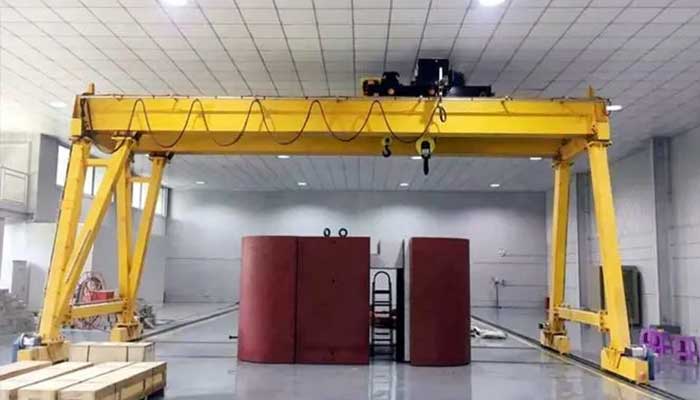
Full-Gantry Cranes
These cranes combine elements of gantry and overhead cranes, offering efficient space utilization in environments with limited overhead space.
Indoor Semi-Gantry Cranes : Indoor semi-gantry cranes are designed for various indoor applications and typically offer capacities from 1 ton to 20 tons. Popular capacities in this category are 2 tons, 5 tons, 10 tons, and 20 tons, making them versatile for different indoor industrial tasks.
Outdoor Semi-Gantry Cranes: Outdoor semi-gantry cranes are built to withstand outdoor conditions and handle heavier loads. They typically provide capacities ranging from 10 tons to 50 tons. Popular capacities include 20 tons, 30 tons, 40 tons, and 50 tons, suitable for outdoor heavy lifting and construction activities.
Key Features:
- Space-Efficient Design: Optimal for areas with limited overhead clearance.
- High Load Capacity: Supports moderate to heavy loads effectively.
- Adjustable Options: Includes height adjustment features for flexibility.
- Typical Applications: Suitable for warehouses and production facilities where space efficiency is important.
- Load Handling: Typically from 5 tons to 20 tons.
Specialized Maintenance Cranes for Light Load Handling
KBK Cranes (Light Crane Systems)
Overview: KBK cranes, also known as light crane systems, feature a modular design using lightweight materials. They are designed for flexibility and can be easily customized to fit various maintenance needs.Applications:- Automotive Repairs: Efficiently handles and positions smaller automotive parts and tools.
- Electronics Assembly: Facilitates the precise handling of delicate electronic components.
- Small Parts Handling: Ideal for moving and positioning small parts in various industrial settings.
Load Capacity: Up to 2 tons.
Benefits:
- Modular Design: Allows for easy customization and reconfiguration.
- Flexibility: Adaptable to different maintenance tasks and environments.
- Ease of Installation: Quick to set up and adjust as needed.
Monorail Cranes
Overview: Monorail cranes operate on a single rail system, providing linear movement along a fixed path. They are particularly useful for transporting small loads along designated routes.Applications:- Conveyor Systems: Integrates seamlessly with conveyor systems for material transport.
- Tool Maintenance: Facilitates the movement of tools and small components to maintenance stations.
- Light Material Handling: Handles light materials and parts efficiently along a fixed path.
Load Capacity: Up to 1 ton.
Benefits:
- Linear Movement: Ensures efficient transport of materials along a specific route.
- Space Efficiency: Saves floor space by utilizing overhead rail systems.
- Fixed Path: Provides consistent and reliable movement for small loads.
Underhung (Underslung) Cranes
Overview: Underhung or underslung cranes are mounted on the ceiling or overhead structures, making them ideal for environments where floor space is limited. These cranes are designed to optimize overhead space and improve accessibility.Applications:- Cleanrooms: Essential for handling equipment and materials in cleanroom environments while keeping the floor clear.
- Laboratories: Provides a compact and efficient solution for maintaining and managing lab equipment.
- Tight Manufacturing Spaces: Perfect for environments with limited floor space and high overhead clearance.
Load Capacity: Typically handles loads up to 5 tons.
Benefits:
- Space Efficiency: Utilizes overhead space, keeping the floor area unobstructed.
- Compact Design: Suitable for confined spaces and areas with limited floor space.
- Accessibility: Allows for easy access to equipment and materials without interfering with workspace.
Key Features of Maintenance Cranes
Understanding the essential features of maintenance cranes is crucial for selecting the right equipment for specific tasks. Here's a detailed look at the key features:Load Capacity
Matching the crane's load capacity to the maintenance tasks is critical for ensuring safe and effective operation. An appropriately rated crane can handle the weight of the items being lifted or moved without risking failure. Here are key considerations:- Task Matching: Choose a crane with a load capacity that aligns with the maximum weight of the items you need to handle.
- Safety: Proper capacity prevents overloading, which could lead to equipment failure or safety incidents.
- Performance: Using equipment with suitable load ratings ensures efficient and reliable operation.
Mobility and Flexibility
Mobile cranes offer significant advantages by enhancing versatility through easy movement and repositioning. This feature is particularly beneficial for tasks requiring access to various areas or frequent relocation. The benefits include:- Adaptability: Mobile cranes are suitable for a range of maintenance scenarios and can handle changing work environments.
- Efficiency: Quick repositioning reduces downtime and accelerates task completion.
- Space Efficiency: Ideal for environments with limited space or where permanent crane installations are not feasible.
- Portable Gantry Cranes: Lightweight and easily movable, these cranes are perfect for temporary setups and small-scale maintenance tasks.
- Jib Cranes: Equipped with mobile bases, they offer flexibility in confined spaces and can be repositioned as needed.
Precision and Control
Precision in load handling is essential for maintenance tasks involving delicate components or requiring exact placement. Accurate control minimizes the risk of damage and ensures proper positioning. Key aspects include:- Accuracy: Precision is necessary for handling sensitive or high-value items to avoid mishandling.
- Control Systems: Advanced controls and feedback mechanisms enhance the ability to handle loads accurately.
- KBK Cranes: Their modular design allows for precise adjustments and flexibility, making them ideal for tasks that require exact control.
- Jib Cranes: Provide excellent maneuverability and control, particularly in smaller or constrained work areas.
Ease of Installation and Use
Cranes that are easy to install and operate contribute to quicker setup and reduced training time, leading to improved operational efficiency. Considerations include:- Installation: Quick and straightforward setup processes minimize downtime and reduce installation costs.
- Operation: User-friendly controls simplify operation, lowering the learning curve and boosting productivity.
- Portable Gantry Cranes: Known for their easy assembly and disassembly, these cranes are ideal for temporary maintenance tasks and quick setups.
- Monorail Systems: Their simple linear design makes them easy to install and operate, particularly useful for material handling in production lines and workshops.
These features collectively ensure that maintenance cranes are well-suited to meet specific operational needs, enhancing safety, efficiency, and precision across various industrial settings.
Typical Applications of Maintenance Cranes by Industrial Sector
Automotive Industry
Typical Loads: Automotive maintenance cranes are used to handle engines, transmissions, axles, car body parts, and various machinery components.
Crane Capacity: These cranes typically have a capacity of up to 10 tons for lighter tasks, with heavier cranes required for larger components.
Typical Applications:
- Assembly Line Maintenance: Used for repairing and adjusting assembly line machinery.
- Engine Replacement: Essential for lifting and installing engines.
- Parts Handling: Facilitates the movement of various automotive components and machinery.
Aerospace Industry
Typical Loads: In the aerospace sector, cranes manage heavy components such as aircraft engines, landing gear, wings, and fuselage sections.
Crane Capacity: Cranes in this industry can handle up to 50 tons, depending on the size of the component.
Typical Applications:
- Engine Maintenance: Crucial for servicing and replacing aircraft engines.
- Component Assembly: Used for assembling large aircraft parts.
- Heavy Equipment Handling: Efficient in moving substantial aerospace components.
Manufacturing Industry
Typical Loads: Cranes in manufacturing are used to lift machinery parts, molds, dies, and various tools.
Crane Capacity: Generally, these cranes have a capacity of up to 10 tons for common tasks.
Typical Applications:
- Equipment Repairs: Essential for fixing and maintaining production machinery.
- Tool Handling: Facilitates the movement and positioning of tools and dies.
- Mold Changes: Used for replacing or adjusting molds used in manufacturing.
Oil and Gas Industry
Typical Loads: Maintenance cranes in the oil and gas sector handle valves, pumps, pipes, and drilling equipment.
Crane Capacity: These cranes range from 10 tons to over 100 tons for handling heavy components.
Typical Applications:
- Refinery Maintenance: Important for servicing and repairing equipment in refineries.
- Offshore Platform Servicing: Used for handling equipment on offshore rigs.
- Equipment Replacement: Facilitates the replacement of large components like pumps and valves.
Power Generation Industry
Typical Loads: Cranes in power generation manage turbines, generators, transformers, and boilers.
Crane Capacity: These cranes are capable of lifting from 20 tons to over 100 tons for large components.
Typical Applications:
- Power Plant Maintenance: Essential for servicing and maintaining power generation equipment.
- Equipment Replacement: Used for replacing large machinery and components.
- Boiler Servicing: Facilitates the handling and installation of heavy boiler parts.
Steel and Metal Processing Industry
Typical Loads: Maintenance cranes here deal with steel coils, billets, and heavy machinery parts.
Crane Capacity: Typically, these cranes handle loads up to 50 tons or more.
Typical Applications:
- Steel Handling: Used for moving and positioning steel products.
- Machinery Repair: Facilitates the servicing and maintenance of processing equipment.
- Equipment Maintenance: Handles and replaces large machinery parts.
Food and Beverage Industry
Typical Loads: In this industry, cranes manage production equipment, maintenance tools, and machinery components.
Crane Capacity: Cranes typically have a capacity of up to 5 tons, depending on equipment size.
Typical Applications:
- Equipment Servicing: Used for maintaining production machinery and equipment.
- Tool Handling: Facilitates the movement of tools and parts used in food processing.
- Production Line Maintenance: Essential for repairing and maintaining production lines.
Pharmaceutical Industry
Typical Loads: Cranes in the pharmaceutical sector handle cleanroom equipment, production machinery, and containers.
Crane Capacity: Typically, these cranes are designed for up to 2 tons for cleanroom applications.
Typical Applications:
- Cleanroom Maintenance: Used for servicing equipment in sterile environments.
- Equipment Replacement: Facilitates the installation and replacement of production machinery.
- Tool Handling: Moves tools and components used in pharmaceutical production.
Mining Industry
Typical Loads: Maintenance cranes in mining handle mining equipment, replacement parts, and motors.
Crane Capacity: Cranes can handle up to 50 tons or more for heavy components.
Typical Applications:
- Equipment Maintenance: Essential for servicing heavy mining machinery.
- Parts Replacement: Used for replacing large components in mining equipment.
- Tool Handling: Facilitates the movement of tools and parts used in mining operations.
Marine and Shipbuilding Industry
Typical Loads: Cranes in this industry manage ship engines, propellers, hull sections, and deck equipment.
Crane Capacity: Cranes range from 20 tons to over 100 tons for large marine components.
Typical Applications:
- Ship Maintenance: Used for repairing and servicing ships and marine equipment.
- Engine Installation: Facilitates the installation of large ship engines.
- Hull Repairs: Handles and positions hull sections for repairs.
Railway Industry
Typical Loads: Maintenance cranes here deal with locomotive engines, wheelsets, and rail car components.
Crane Capacity: These cranes can handle up to 30 tons for locomotive components.
Typical Applications:
- Rail Yard Maintenance: Essential for servicing and repairing rail equipment.
- Component Replacement: Used for replacing parts of locomotives and rail cars.
- Repairs: Facilitates maintenance on rail infrastructure and vehicles.
Paper and Pulp Industry
Typical Loads: Cranes in the paper and pulp industry handle paper rolls, pulping machinery parts, and rollers.
Crane Capacity: Typically, these cranes handle loads up to 10 tons.
Typical Applications:
- Paper Roll Handling: Used for moving and positioning large rolls of paper.
- Machinery Maintenance: Facilitates servicing and repairing pulping equipment.
- Tool Servicing: Handles tools and components used in paper production.
Chemical and Petrochemical Industry
Typical Loads: Cranes in this industry handle reactor parts, pumps, compressors, and valves.
Crane Capacity: Cranes can range from 10 tons to 50 tons or more.
Typical Applications:
- Equipment Servicing: Used for maintaining and repairing chemical processing equipment.
- Reactor Maintenance: Facilitates handling parts and equipment within reactors.
- Valve Replacement: Essential for installing and replacing critical valves and pumps.
Maintenance and Safety of Maintenance Cranes
Importance of Regular Maintenance
Regular maintenance of maintenance cranes is crucial for ensuring their safety, reliability, and longevity. Proper upkeep helps prevent equipment failures, reduces the risk of accidents, and extends the service life of the crane. Key reasons for regular maintenance include:- Safety: Well-maintained cranes are less likely to malfunction, which reduces the risk of accidents and injuries.
- Reliability: Routine checks and servicing ensure that the crane operates smoothly and efficiently, minimizing downtime.
- Longevity: Regular maintenance prevents wear and tear, helping to extend the lifespan of the crane and its components.
Common Maintenance Practices
Different types of cranes require specific maintenance practices. Here's a general overview:
Overhead Cranes:
- Inspection: Regularly inspect the hoist, trolley, and bridge for wear and damage.
- Lubrication: Ensure all moving parts are adequately lubricated to prevent friction and wear.
- Structural Checks: Examine the crane's structure for signs of fatigue or cracks.
- Track Maintenance: Inspect and clean the tracks to ensure smooth movement.
- Gear and Motor Checks: Regularly check the gears and motors for proper operation and lubrication.
- Stability Assessment: Ensure the crane's legs and supports are stable and secure.
- Jib Arm Inspection: Check the jib arm for signs of wear or damage.
- Load Testing: Perform load tests periodically to ensure the crane can handle its rated capacity.
- Cable and Wire Checks: Inspect cables and wires for fraying or damage.
- Rail Inspection: Regularly check the rails for alignment and wear.
- Trolley Maintenance: Ensure the trolley moves smoothly along the rail.
- Component Cleaning: Keep all components clean and free of debris.
- Track Alignment: Check the alignment of the monorail track to prevent derailments.
- Trolley Maintenance: Inspect the trolley for wear and ensure smooth operation.
- Lubrication: Lubricate the track and trolley mechanisms as needed.
- Ceiling Mount Checks: Ensure the crane is securely mounted to the ceiling or support structure.
- Movement Inspection: Verify smooth movement along the overhead beams.
- Component Inspections: Regularly check the hoist and trolley for wear.
Safety Protocols and Guidelines
Adhering to safety protocols is essential for the safe operation of maintenance cranes. Key guidelines include:
- Operator Training: Ensure that all crane operators are properly trained and certified.
- Pre-Operation Checks: Perform pre-operation inspections to identify any issues before use.
- Load Limits: Always adhere to the crane's load capacity limits to prevent overloading.
- Maintenance Logs: Keep detailed records of maintenance activities and inspections.
- Emergency Procedures: Establish and train staff on emergency procedures in case of crane malfunctions or accidents.
- Safety Gear: Operators and maintenance personnel should wear appropriate safety gear, including helmets, gloves, and protective eyewear.
- Signage and Warnings: Clearly mark areas around the crane with warning signs and ensure that all safety warnings are visible to operators and personnel.
By following these maintenance practices and safety protocols, you can ensure the efficient and safe operation of maintenance cranes, ultimately protecting both equipment and personnel.
How to Choose the Right Maintenance Crane
Assess Your Needs
Evaluating Load Requirements, Space Constraints, and Operational Needs
The first step in selecting the right maintenance crane is to thoroughly assess your specific needs. Start by evaluating the load requirements: determine the maximum weight and dimensions of the items you'll be handling. This ensures that the crane you choose has the appropriate load capacity and reach. Additionally, consider space constraints within your facility. Measure the available workspace to ensure that the crane will fit and operate efficiently without obstructing other equipment or workflows. Finally, assess your operational needs, such as the frequency of use, the types of maintenance tasks, and whether mobility or flexibility is required. This comprehensive evaluation will help you identify a crane that meets your operational demands and fits seamlessly into your workspace.
Consider Industry-Specific Requirements
Tailoring Crane Selection to Specific Industry Needs
Different industries have unique requirements for maintenance cranes, so it's crucial to tailor your crane selection to your industry's specific needs. For example, in the automotive industry, cranes may need to handle heavy engine components and operate in confined assembly lines. Aerospace industries require cranes that can handle large and delicate aircraft parts with precision. In manufacturing, cranes might need to handle various molds and dies. Understanding these industry-specific requirements will help you choose a crane with the right features, load capacities, and operational capabilities to meet your needs effectively.
Compare Crane Options
Reviewing Different Crane Models and Their Features
Once you have a clear understanding of your needs and industry requirements, compare different crane models and their features. Evaluate various options based on key factors such as load capacity, mobility, precision, and ease of installation. Look at the specific benefits each model offers, such as advanced safety features, adjustable heights, or modular components. By comparing these features, you can determine which crane best aligns with your operational needs and provides the most value. Consider also the manufacturer's reputation, warranty, and after-sales support to ensure you make an informed decision.
Consult with Experts
Seeking Advice from Crane Suppliers and Industry Professionals
Consulting with crane suppliers and industry professionals can provide valuable insights and guidance in selecting the right crane. Suppliers can offer detailed information about different crane models, including their specifications, benefits, and limitations. They can also help you understand which crane best suits your specific needs and budget. Additionally, industry professionals can provide recommendations based on their experience and knowledge of similar applications. By leveraging their expertise, you can make a more informed decision and ensure that the crane you choose will effectively meet your maintenance needs and contribute to optimal operational efficiency.
Maintenance and Support Services
Regular Maintenance
Importance of Scheduled Maintenance for Crane Performance
Scheduled maintenance is crucial for ensuring the ongoing performance and reliability of maintenance cranes. Regular inspections and servicing help prevent unexpected breakdowns and extend the lifespan of the equipment. Maintenance tasks typically include checking and lubricating moving parts, inspecting structural components, and calibrating control systems. By adhering to a regular maintenance schedule, you can address minor issues before they become major problems, ensuring that the crane operates efficiently and safely. Additionally, regular maintenance helps maintain the crane's safety features, reducing the risk of accidents and enhancing overall operational reliability.
Spare Parts and Repairs
Availability of Spare Parts and Repair Services
Having access to spare parts and repair services is essential for minimizing downtime and maintaining crane functionality. Ensure that spare parts for your crane model are readily available from the manufacturer or authorized dealers. This availability is crucial for quick repairs and replacements, which helps to reduce operational interruptions. Additionally, reputable repair services should be accessible to address any mechanical or electrical issues that may arise. Regular checks and a proactive approach to identifying potential problems can also facilitate timely repairs, ensuring that your crane remains in optimal working condition.
Training and Support
Training for Operators and Ongoing Technical Support
Effective crane operation and maintenance require proper training and ongoing technical support. Provide comprehensive training for operators to ensure they are familiar with the crane's features, safety protocols, and operational procedures. Training programs should cover safe lifting practices, routine maintenance tasks, and emergency response procedures. In addition to initial training, ongoing technical support from the crane supplier or manufacturer is vital for addressing any operational issues and keeping operators updated on best practices and new technologies. Access to technical support can help resolve problems quickly and efficiently, ensuring that your crane remains a valuable asset to your maintenance operations.
Conclusion
In this guide, we have explored various types of maintenance cranes available for sale, including overhead cranes, gantry cranes, jib cranes, KBK cranes, monorail systems, and underhung cranes. Each type of crane has distinct features and capabilities suited to different maintenance tasks and operational environments. We examined their key characteristics, typical load capacities, and specific benefits for reducing downtime.
Overhead Cranes are ideal for large-scale operations with heavy loads, providing broad coverage and efficiency. Gantry Cranes offer flexibility for both indoor and outdoor use, suitable for large and heavy components. Jib Cranes are valuable for precision tasks in confined spaces, enhancing maneuverability. KBK Cranes provide modularity and flexibility for lighter loads and customizable setups. Monorail Systems are efficient for linear movement in limited spaces, while Underhung Cranes maximize floor space in environments with constrained overhead.
We also highlighted essential features to consider, such as load capacity, mobility, precision, and ease of installation, which impact crane performance and suitability for specific maintenance needs.
Selecting the right maintenance crane is crucial for minimizing downtime and maximizing operational efficiency. The right crane can significantly impact your maintenance operations, enhancing productivity, safety, and cost-effectiveness. By choosing a crane that aligns with your specific requirements—whether it's for handling heavy loads, operating in confined spaces, or providing precise control—you can ensure that your maintenance tasks are performed efficiently and effectively. Proper crane selection not only improves operational efficiency but also contributes to the longevity of your equipment and reduces overall maintenance costs.
Frequently Asked Questions (FAQs)
What is the primary purpose of maintenance cranes?
Maintenance cranes are designed to lift, move, and position heavy equipment and components during maintenance and repair operations. They are essential for ensuring that machinery and equipment can be serviced or replaced efficiently and safely.
How do I choose the right crane for my maintenance needs?
When selecting a maintenance crane, consider the following factors:
- Load Capacity: Ensure the crane can handle the weight of the items you need to lift.
- Workspace Size: Choose a crane that fits your operational space, whether it's a compact jib crane or a larger overhead crane.
- Type of Maintenance: Match the crane type to the specific maintenance tasks, such as jib cranes for precision lifting or gantry cranes for heavy-duty tasks.
- Mobility Needs: Decide if you need a stationary or mobile crane based on your workflow and space constraints.
What are the benefits of overhead cranes in maintenance work?
Overhead cranes provide broad coverage and can handle very heavy loads, making them ideal for large-scale maintenance operations. They are particularly useful in environments with high ceilings and large open spaces, such as manufacturing plants and warehouses.
Can gantry cranes be used for outdoor maintenance?
Yes, gantry cranes are versatile and can be used both indoors and outdoors. They are well-suited for environments where heavy equipment needs to be lifted and transported over long distances, such as construction sites and shipyards.
How often should maintenance cranes be inspected?
Maintenance cranes should be inspected regularly, typically every three to six months, depending on usage and manufacturer recommendations. Regular inspections help identify wear and tear, prevent breakdowns, and ensure safe operation.
What are common maintenance practices for cranes?
Common maintenance practices include:
- Routine Inspections: Check for signs of wear, damage, and proper functioning of all components.
- Lubrication: Keep moving parts well-lubricated to prevent friction and wear.
- Load Testing: Periodically test the crane with loads to ensure it can handle its rated capacity.
- Cleaning: Regularly clean the crane to remove dust, debris, and contaminants.
What safety measures should be followed when operating maintenance cranes?
Safety measures include:
- Operator Training: Ensure all operators are trained and certified.
- Pre-Operation Checks: Perform thorough inspections before use.
- Adherence to Load Limits: Never exceed the crane's rated capacity.
- Use of Safety Gear: Operators and nearby personnel should wear appropriate protective equipment.
- Emergency Procedures: Establish and communicate emergency protocols.
Are there specific maintenance cranes for confined spaces?
Yes, jib cranes and KBK crane systems are ideal for confined spaces due to their compact design and flexibility. These cranes are well-suited for tasks in smaller workshops and tight areas where space is limited.
What is the advantage of using a KBK crane system?
KBK crane systems offer high flexibility and modularity, allowing for easy reconfiguration and expansion. They are ideal for environments where frequent changes in layout or operational needs occur, such as small workshops and assembly areas.
How do I maintain crane safety in my facility?
To maintain crane safety, ensure regular inspections and maintenance, train operators thoroughly, adhere to safety protocols, and keep detailed maintenance logs. Additionally, clearly mark crane operation areas with warning signs and ensure emergency procedures are in place.
These answers aim to address common questions and provide clarity on maintenance cranes, helping you make informed decisions and ensure safe and efficient operations.
Common Questions
What is the difference between overhead cranes and gantry cranes?
Overhead cranes are mounted on rails fixed to the ceiling or upper structure, allowing them to move horizontally and vertically within a facility. They are ideal for large-scale operations where heavy items need to be moved across a broad area. Gantry cranes, on the other hand, are supported by legs that move on tracks, making them versatile for both indoor and outdoor environments. They are often used for handling heavy and oversized loads, with the ability to adjust the height and span as needed.
How do I determine the right crane capacity for my needs?
The right crane capacity depends on the weight and size of the loads you need to handle. Assess the maximum load weight and dimensions of the items to be lifted. Consider any future needs or potential increases in load requirements. Choosing a crane with a capacity that exceeds your maximum load will ensure safety and reliability.
What factors should I consider when choosing a crane for confined spaces?
For confined spaces, cranes with compact designs and high maneuverability are essential. Jib cranes and some types of KBK cranes are well-suited for these environments as they offer precision in movement and can operate efficiently within restricted areas. Ensure the crane's dimensions fit within the available space and that it provides adequate reach and control.
How often should maintenance cranes be serviced?
Regular maintenance is crucial for optimal crane performance and safety. Scheduled maintenance should typically be performed according to the manufacturer's recommendations, which might include daily, monthly, and annual checks. Routine inspections help identify wear and tear, ensuring that the crane remains in good working condition and preventing unexpected breakdowns.
What are the benefits of using mobile cranes for maintenance tasks?
Mobile cranes offer the advantage of flexibility and adaptability, allowing for quick repositioning and easy access to different areas within a facility. They are particularly useful for tasks that require frequent relocation or where fixed cranes are not feasible. Their mobility enhances efficiency and reduces the time needed for maintenance tasks.
Related Products

Latest project
150 Ton Overhead Crane Installation Feedback – Paraguay Case
QDX 150 ton overhead crane in action in Paraguay. Installation photos, video, and client feedback show performance, safety, and heavy-lifting efficiency.
Free consultation to Confirm Parameters & Specifications and Get
Latest Crane Price & Crane Rate.
- Types of overhead cranes : _______?
- Optional: Overhead travelling crane, goliath gantry crane,Slewing jib crane, Single girder or double girder crane,small portable crane or kbk crane, etc.
- Capacity of overhead crane: _______?
- Optional: 0.25ton, 0.5 ton, 1 ton, 2 ton, 3ton, 5 ton, 10 ton,15ton, 20ton, 25 ton, 30ton,35ton, up to 550ton, etc.
- Crane span & lifting height : _______?
- Crane travelling length : _____?
- Control of overhead crane:_______?
- Optional: pendant/ remote/cabin control
- Voltage supply of overhead crane:_____?
- Eg,: 380V50/60HZ,3Phase or others,etc.
- Application/usage of crane:_______?
- Eg,: Steel mill, ,injection mold, cement,stone, concrete,granite, general manufacturing, etc.
Just leave a message via the contact form and our hoist and crane engineer will contact you with in 24working hours.
Get In Touch
